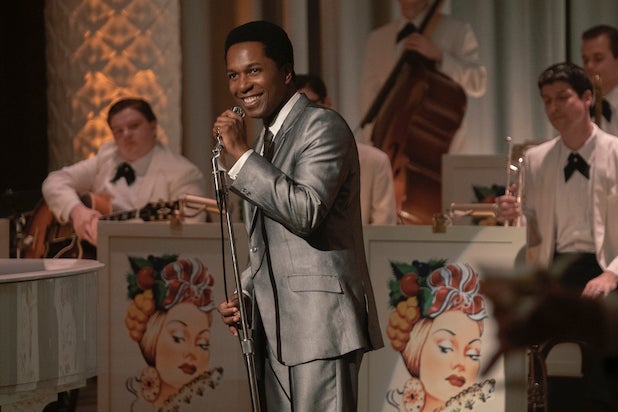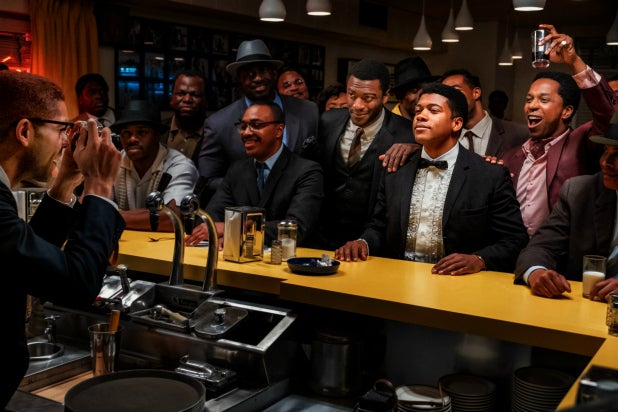'One Night in Miami' Costume Designer Explains How She Dressed Four Iconic American Figures
“If the actor is wearing something that has meaning, the performance flows with even more authenticity,” says veteran costumer Francine Jamison-Tanchuck
Amazon Studios
Francine Jamison-Tanchuck’s lifetime of movie credits as a costume designer read like a history of Hollywood over the past 40 years. The St. Louis native began her career in the wardrobe department with back-to-back Jane Fonda movies in the late-1970s (“Comes a Horseman” and “The Electric Horseman”), then worked on ’80s classics like “The Color Purple,” “Body Double,” “The Running Man,” and “Coming to America,” before her first gig as department head, dressing an entire army, for 1989’s Civil War epic “Glory.”
In an industry that still suffers a shortage of Black women in leadership roles, Jamison-Tanchuck forged a career for herself in practically every genre and budget: “White Men Can’t Jump,” “Boomerang,” “Courage Under Fire,” “Big Momma’s House,” “Birth of a Nation,” “Roman J. Israel, Esq.,” “Detroit,” “Just Mercy” make up just a sampling of her filmography. But it was while working on 2007’s holiday film “This Christmas,” starring Loretta Devine and Delroy Lindo, that Jamison-Tanchuck first met the young actress Regina King, a few years before King would win four Emmys (for “American Crime,” “Seven Seconds,” and “Watchmen”) and an Oscar (“If Beale Street Could Talk”).
The costume designer remembers that experience well. “I have very warm memories from that film,” she said to TheWrap. “The whole cast was really cohesive, they actually seemed like a real family, and Regina was absolutely great.”
More than a decade later, King and Jamison-Tanchuck reconnected on the phone. The topic of conversation was King’s directorial debut “One Night in Miami,” which tells the thinly fictionalized version of a meeting in a hotel room in 1964 between four legends of history: singer Sam Cooke (Leslie Odom Jr.), activist Malcolm X (Kingsley Ben-Adir), football star and actor Jim Brown (Aldis Hodge), and boxer Cassius Clay, soon to be Muhammad Ali (Eli Goree).
“Regina reached out to me and I was pleasantly surprised,” Jamison-Tanchuck said. “I hadn’t spoken to her in awhile but she was working with a friend of mine, Sharon Davis, who is awesome, and was costuming Regina on ‘Watchmen.’ I had just finished a film and was enjoying being home when Regina called and asked what my availability was. I was planning to go on a couple of cruises with my husband. We did sail to St. Thomas, Puerto Rico, and the British Virgin Islands — this was in December of 2019 and we did notice a lot of hand sanitizer on the boat — and then I was free to work on ‘One Night in Miami’ when we came back.”
The project, Jamison-Tanchuck explained, was one of the most invigorating she’d ever been involved with. “This was a wonderful, important story to be told and such an opportunity for Regina as a director. I’m just so happy for her. And these four amazing actors, too. They were just so excited to play these roles, to have a sense of what these men were going through in those days. We know what many African American men go through now. We can only imagine what they were going through then, decades ago.”
Jamison-Tanchuck walked us through each of the four main characters and her experience with the research of the real-life men, and her collaboration with the actors portraying these roles.
Kingsley Ben-Adir as Malcolm X
“Malcolm X’s clothing was somewhat dated. In the mid-1960s, his suits were from the ’50s. He really didn’t have a big care about fashion or style. And the same thing was true for Kingsley. To him, it was most important that the details were real. He just wanted to feel real as Malcolm in the clothing. When Kingsley came in for fittings, right away we understood just by his attitude that he wanted to feel the reality of Malcolm from the clothing. The clothing really helped Kingsley’s idea of Malcolm’s state of mind.”
Eli Goree as Cassius Clay a.k.a. Muhammad Ali
“In 1964, Ali was having fun in his clothes. He was the youngest in the crowd, so I figured he was a bit more progressive in terms of what he wore. He was trying new things and going forward. When Eli was in wardrobe as Ali, he was so concerned about being able to move in the clothing. Eli is six-foot-two and he knew he needed to be very loose and effortless in his movements. Ali was always shadow boxing, in his own way, regardless of where he was. He would play around with his friends and even with journalists, pretending to box them. This was the reality. So Eli was very concerned about the clothes being able to flow with his body movements.”
Aldis Hodge as Jim Brown
“Jim Brown is the only one of these four men who is still alive. And the only one who I once worked with, on the film “The Running Man.” We found footage of him wearing a beautiful three-piece suit around the time when the film takes place. He had a style of his own, that’s for sure, but was also a bit more conservative at the time. So I kept that in mind. What I remember most is that Aldis was the first to finish all his scenes. And before we knew it he was done with the shoot. It seemed like it all went so quickly. I gave him a big hug and thanked him for his wonderful performance.”
Leslie Odom Jr. as Sam Cooke
“Sam Cooke was the most fashionable of the four men. And so the most exciting challenge of all for me. He was very much a fashion plate, very before his time. His fashion sense was looking forward, not only for African American men but for men, period. Especially in the entertainment industry. Of the four men, he was the most into clothing.
“Leslie really wanted to make sure that we did Sam Cooke justice with his style. And I said, “Yes! Bravo!” Sometimes actors aren’t into all the crafts around their performance as much. But Leslie loved it. So in many ways, I was fitting Sam Cook’s fashion style with Leslie’s fashion style. Leslie loved the sharkskin suits, very indicative of the ’60s.
There were a set of cufflinks that were given to Sam Cooke by the owner of the Copacabana. And he wore them on the Johnny Carson show. We were able to replicate those for the costume. It’s a small detail that’s actually a big detail. When we replicated those cufflinks, it meant a lot to me and a lot to Leslie. Because if the actor is wearing something that has that kind of meaning, and the actor knows and understands it, the performance flows with even more authenticity. I think those cufflinks really helped Leslie understand Sam Cooke.”
Source: Read Full Article

